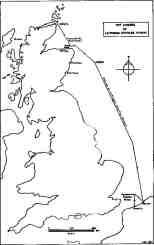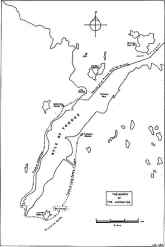|
CAITHNESS FIELD CLUB BULLETIN vol. 3 No. 5 April 1983 AN EIGHTEENTH CENTURY SEA BATTLE IN THE KYLE OF TONGUE Writing his diary on Wednesday night, 26th March 1746 the Reverend Murdo MacDonald, minister of Durness, made the following entry referring to the previous day: "Yesternight we heard in the evening throng cannonading to the eastward. Some thought the noise too loud to be far off, and too low to be near; but this afternoon we are told it was an engagement between a French ship and one of our men-of-war, which happen'd about Tongue, where the French vessel was driven ashore below Melness. Out of her landed some hundreds of men, who were met by our Flying Company on the frontiers of this parish, and some killed and the rest taken prisoners and delivered to the man-of-war. There may be several different accounts of this matter hereafter; but as it is critical, perhaps the Divine Providence may be seen in it conspiciously yet." What were the events leading up to this entry, and what happened subsequently? The vessel flying the French flag and sailing under the name of "Le Prince Charles Stuart" was in fact the British sloop "Hazard" which had been captured in November 1745 by Angus Jacobites in Montrose Harbour. She had then been sailed with a French crew to Dunkirk where she was renamed. Le Prince Charles Stuart was a sloop of 270 tonnes with an armament of twelve six-pounders. Her complement would have been some 20 officers and 120 soldiers and sailors. With Prince Charles Edward Stuart and his Jacobite followers running short of arms, stores and money Le Prince Charles Stuart was sent from Dunkirk by King Louis XV of France in the middle of March 1746. She was to sail under the command of George Talbot, Capitaine de fregate of the French navy, to deliver over �13,000 in english gold coin and louis d'or, and supplies for the Prince in Inverness. Unfortunately soon after leaving Dunkirk she was attacked by two English privateers and driven ashore at Ostend where she was thought to be severely damaged. However her damage could not have been serious for she was repaired and later left Ostend pursued by six or seven English ships from which she managed to escape. Since the escape of the Doutelle, the French brig from Nantes which eventually landed Prince Charles at Loch nan Uamh in 1745, a Western Squadron of the English fleet had been stationed, under the command of Admiral Vernon, in the Channel. For this reason Le Prince Charles Stuart sailed northwards but well clear of the English coast. The intention was to sail into the small harbour at Portsoy in Banffshire under cover of darkness, and if the port was still in friendly hands volunteer officers and soldiers of the Irish regiments on board would be landed with the gold coin to be escorted to the Prince in Inverness. By Monday 24th March Le Prince Charles Stuart was as far north as Aberdeenshire and by evening Captain Talbot altered course to westwards to take her along the Banffshire coast. As darkness was falling he spotted four English ships of Commodore Smith's squadron at anchor off Troup Head. They were the forty gun Eltham, the twenty-four gun Sheerness together with the two sloops Hawk and Hound. Immediately Captain Talbot swung his ship to starboard to set a northerly course with full speed, and the Sheerness, under the command of Captain Lucius O'Brien, was detached from the squadron to give chase. The frigate Sheerness had superiority over Le Prince Charles Stuart. She was a vessel of some 450-500 tonnes and armed with 24 guns including 22 nine-pounders. Her complement included some 160 men. During the night by the light of the moon Captain Talbot could see his pursuer coming closer, and to make matters worse the wind had fallen. In order to effect an escape he put his crew to the oars and after the moon became obscured by cloud he managed to evade the enemy vessel. The respite had been short-lived for as the dawn broke on Tuesday 25th March, and with Le Prince Charles Stuart nearing the eastern approach to the Pentland Firth, the Sheerness was again in view astern. What was worse, Talbot had little detailed knowledge of the north coast so he took on board two local fishermen to act as pilots. With the superior speed of the Sheerness it was obvious that Le Prince Charles Stuart was going to be overhauled before she reached the Minch. Some drastic action was therefore necessary if she was going to escape. After consultation Captain Talbot was advised that if he could make the Kyle of Tongue the shallower draught of his vessel might enable him to sail further into the Kyle and hence evade the guns of the Sheerness. By this means he would be able to land his cargo ashore well ahead of his pursuer. By late afternoon, and on an ebbing tide, Le Prince Charles Stuart sailed through Caol Raineach past the Rabbit Islands and into Tongue Bay. With mudbanks on each side the channel into the Kyle is tortuous and not easy to navigate by those unfamiliar with its course. Consequently below Melness Captain Talbot had the misfortune to run his ship aground on the western sandbank. He dropped anchor and managed to manoeuvre his ship so that it was broadside on to the approaching Sheerness who despite her greater draught skilfully sailed to within firing range of her guns. For Captain Talbot and his crew the situation was now desperate. His vessel was aground with little immediate hope of getting his valuable cargo ashore, and he was a sitting target for the Sheerness with her overwhelming armament. The events of the next few hours were inevitable as each ship bombarded the other with broadsides, but the superior fire power of the Sheerness began to cause serious damage to Le Prince Charles. The morale of her crew was low and on the return of the flood tide she began making water. Most of her gunners had been killed or seriously wounded in the running battle which had continued for nearly five hours. Once there was sufficient water in the Kyle again Talbot cut the anchor cable and allowed his ship to drift and finally ground again on the sand of the western shore near to Ard Skinid. Although by this time darkness had fallen the Sheerness still kept up her fire and with discipline becoming harder to maintain Talbot gave the order for the soldiers under the command of their senior officer Colonel Ignatius Brown to transfer the money and stores ashore. Once on land, from the top of Ard Skinid, they observed the Sheeress putting a party ashore to the north. Fearing an attack now from the shore, and with his vessel out of commission Talbot gave the order for the remaining crew to abandon ship. The plan now, under cover of darkness, was for the soldiers and remaining crew to commence a march overland to Inverness more than a hundred miles away carrying the gold and stores with them. After burying some of their dead the long march began. They had not travelled far when they came across Melness House where they discovered the laird William Mackay had Jacobite sympathies. Although the chief of clan Mackay Lord Reay, whose residence was at Tongue house on the other side of the Kyle, was strongly against the Jacobite causes, William Mackay and his family had always been Stuart supporters. He therefore gave useful advice about the route to Inverness, sold two of his horses to the marchers to help carry the gold, and also sent his son as a guide. Towards the head of the Kyle the march continued. Meanwhile, once it became daylight on the Wednesday of 26th March Captain O'Brien despatched some of his crew by boat in an attempt to refloat the stranded Le Prince Charles Stuart. It was then that he discovered that the vessel was in fact the Hazard of whose earlier capture from Montrose he was aware. At the same time he also despatched a second boat party across the Kyle to Tongue House to seek assistance. Lord Reay's militia and about a hundred men of Lord Loudon's regiment including Captain Alexander Mackay, Sir Henry Munro, Macleod and Lord Charles Gordon; two subalterns, and the surgeon; were at this time in the vicinity of Tongue. On learning of the situation Lord Reay summoned as many men as possible and about fifty of his own men together with another fifty of Lord Loudon's marched from Tongue and within two hours intercepted the Jacobites. On being attacked the Jacobites returned fire and Lord Reay's men, after discharging their firelocks, attacked sword-in-hands. The Jacobites then with five or six men killed and as many wounded, seeing further reinforcements arriving under Captain George Mackay, surrendered. A second relevant entry in the diary of the Reverend Murdo MacDonald made on Sunday evening 30th March 1746 reads: "The ship from France of which mention was made already, in which was 150 or 160 men, who with their treasure, consisting of, as we hear, �13,000 ster., were taken with no loss to our men. This ship, is like to prove a bone of contention between some of our stranger Dons, in a sort of exile with us at present, and our own great folks, who dispute the prize with them, and are like to cast out about the division thereof. And this on account of the absence of our native officers, who, being on a post of defence in the skirts of the parish, could not be got time enough to the little skirmish in which the French were taken at Druim-na-Cub, about three miles to the south of Tongue, which made the strangers appear at the head of the few scattered men that could first be apprized in the neighbourhood. Such is the account we have of this matter, which threatens, among other things, the enemy's coming upon us and snatching away the contenders with their prey, while they are differing among themselves about it." After the surrender the prisoners were marched to Tongue and the same night put aboard the Sheerness. The Hazard received temporary repairs and, after being taken to Leith, subsequently rejoined the Hanoverian navy. Of the officers taken captive the following are named: Colonel Ignatius Brown
of Berwick's regiment; Captains Macmahon and Rogers; After custody in Aberdeen the prisoners were moved to Berwick castle. Later, after Cumberland's victory at Culloden they were repatriated as prisoners of war. Of the money, most appears to have been recovered although there Less than three weeks later on 16th April 1746 the Jacobite cause was lost of the battlefield of Culloden. R E F E R E N C E S |

